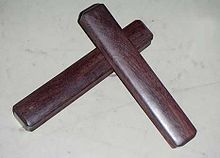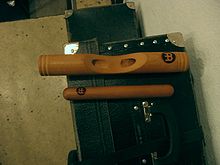Claves
![]()
This article is about the percussion instrument claves. For other meanings, see Claves (disambiguation).
Claves, tone woods or bars, also called rumba woods or rumba sticks, are percussion instruments used in pairs from the group of counter-percussion idiophones. The two round wooden sticks of equal length, as they are used as rhythm instruments especially in Latin American music, produce a dry sound almost without reverberation.
![]()
This article or subsequent section is not sufficiently supported by evidence (e.g., anecdotal evidence). Information without sufficient evidence may be removed in the near future. Please help Wikipedia by researching the information and adding good supporting evidence.
The claves originate from Africa and have gained importance especially in Cuba. In Cuban music you almost always hear the claves - be it Son, Rumba, Salsa or Salsaton. In Colombian or Puerto Rican Salsa the claves are played less often, but they are a typical feature of Cuban Salsa.
These are prismatic bars of circular or flatter cross-section and 18 to 30 cm in length which, when struck against each other, produce a high piercing tone. The materials used are hardwood and - possibly fibre-reinforced - plastic.
To play, one wooden stick lies approximately horizontally on the upwardly open hand, resting at 2 points - ideally near the vibration nodes at about 20 and 80% of its length - on the ball of the thumb or several fingertips. The second wooden stick is held loosely between the thumb and 1 or 2 fingers of the second hand at about 20% of its length and is twisted horizontally by about 60° in relation to the first wood. To produce the sound, the end of the second stick is struck from above, rocking on the middle of the first stick. Sound emanating from the vibrating sticks is reflected by the hands, which also form resonance chambers for the air in their curvatures.
In their origins the claves were long wooden ship's nails used as percussion instruments. Hence the name (Spanish clavo, "nail"). Claves is often mistakenly translated as "key", but this is not true in this context.
Despite their simplicity, claves are fundamental to various styles of Latin American music, especially son, salsa and bossa nova, as they form the basic rhythmic framework for this music (clave), which all other (percussion) instruments follow. A variant from Puerto Rico is called Cuá.
The playing (beat) of the clave is typical and there are seven basic types of rhythm produced with the claves. 6/8 clave (origin), 2/3 son clave, 3/2 son clave, 2/3 rumba clave, 3/2 rumba clave, 2/3 bossa nova clave, 3/2 bossa nova clave. 2/3 means two beats in the first 4/4 and three beats in the second 4/4. The beats are played on whole and half notes, which in turn differ according to Son, Rumba or Bossa Nova. The clave has evolved, and Latin jazz now features clave rhythms in 7/4 or 10/4 time. The best known rhythm is 3/2 Son Clave, because it starts on one in time.
However, in Salsa the 2/3 Son Clave is heard in majority (starts on two). For a layman, it is difficult to tell the difference during a piece of music, especially when the clave is not played. The entire rhythmic framework relies on the clave's lead. The congas, for example, are played entirely to the rhythm of the clave. A professional congalero thinks in time with the clave and plays the rhythm of the congas.
Tone woods have a long tradition in various cultures. The Australian Aborigines, for example, use eucalyptus wood for their clapsticks.
![]()

This is how the lower sound bar is held.

A pair of claves

Hollowed African Claves
Quotes
- Si vienes del extranjero y tu lo quieres bailar, lleva el ritmo de las claves - "If you come from far away and want to dance it (the Son), feel the rhythm of the claves."
- sin clave y bongó no hay son - "Without clave and bongo there is no son."
Search within the encyclopedia